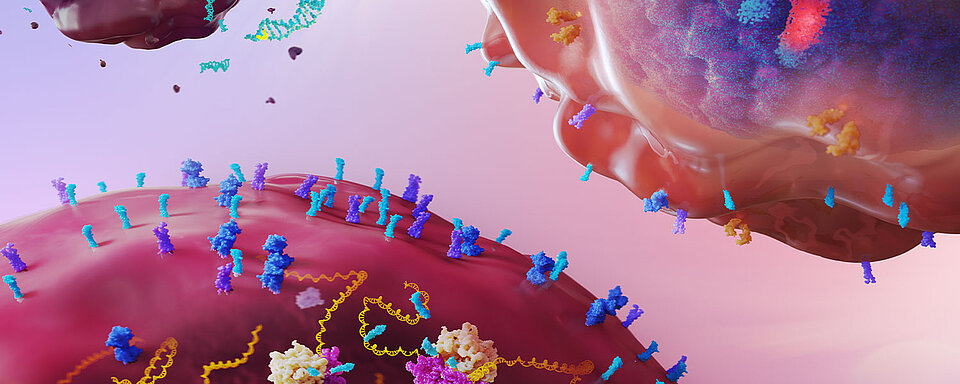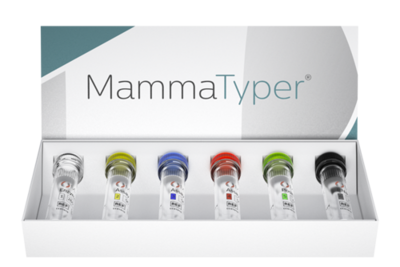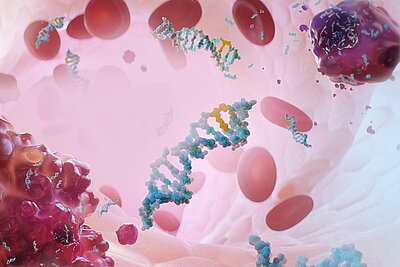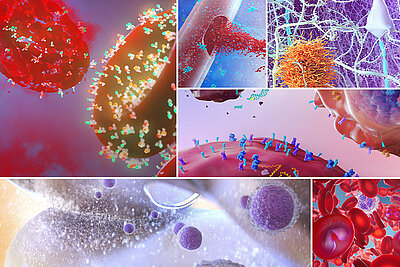Scientific Calendar May 2025
Zooming in on cancer through a molecular lens
What are the key molecular biomarkers for breast cancer classification?
Estrogen receptor (ESR1), progesterone receptor (PR), HER2 and Ki-67
Estrogen receptor (ESR1), progesterone receptor (PR) and HER2
Epidermal growth factor receptor (EGFR), estrogen receptor (ESR1), progesterone receptor (PR) and HER2
Congratulations!
That's the correct answer!
Sorry! That´s not completely correct!
Please try again
Sorry! That's not the correct answer!
Please try again
Notice
Please select at least one answer
A patient's journey through personalised breast cancer treatment
In 2019, during her annual routine check-up, a 54-year-old woman discovered a mass in her left breast, prompting immediate medical attention. Ultrasound examination and subsequent tissue biopsy confirmed breast cancer with clinical node positivity. Further molecular assessments, including mRNA expression analysis and cytogenetics, revealed high Ki-67 and high hormonal expression (ER+), classifying it as a luminal B HER2-negative subtype. This key molecular classification guided the selection of the most appropriate treatment approach.
Recent advances in oncology have revolutionised cancer diagnosis and treatment, making approaches more precise and less invasive. The sentinel lymph node concept, combined with molecular subtyping, has significantly improved cancer characterisation, prognosis estimation, and treatment personalisation. These advancements support more informed treatment decisions and enable familial genetic counselling where hereditary risk factors are identified.
Molecular genetic subtyping provides essential insights into tumour biology. Tools like MammaTyper® allow pathologists and oncologists to subtype breast cancer more accurately, differentiating between luminal A, luminal B, HER2-enriched, and triple-negative subtypes. This subtyping defines treatment selection, ensuring patients receive the most effective therapies, tailored to their tumour profile.
Based on her diagnosis, the patient underwent neo-adjuvant therapy. However, the tumour exhibited only minimal shrinkage, necessitating surgical intervention. The molecular assessment of nodal metastasis via CK19 mRNA quantification confirmed locally advanced disease.
Lymph node involvement is a key prognostic factor in breast cancer. The OSNA (One-Step Nucleic Acid Amplification) assay provides an accurate and rapid assessment of sentinel lymph node metastases by quantifying CK19 mRNA copies. Unlike conventional histopathology, OSNA enables intraoperative decision-making, optimising surgical outcomes and reducing unnecessary lymph node dissections.
Following surgery, she commenced a regimen combining hormone therapy with CDK4/6 inhibitors, designed to prevent cancer progression by targeting cell cycle dysregulation. Recognising the high risk of recurrence associated with luminal B breast cancer, her oncologist opted for a vigilant monitoring strategy. When early imaging signs of recurrence appeared, her oncologist leveraged liquid biopsy technology to assess ESR1 mutational status through circulating tumour DNA (ctDNA) analysis. This minimally invasive approach enabled rapid detection of emerging resistance mutations, allowing for timely adaptation of her treatment plan to a more appropriate targeted therapy.
Despite surgical and/or systemic primary treatment, up to 30% of breast cancer patients experience recurrence. Liquid biopsy, particularly ctDNA analysis, has emerged as a minimally invasive solution for real-time monitoring of disease progression, therapy response, and resistance mutations. The Plasma-SeqSensei Breast Cancer IVD Kit uses next-generation sequencing (NGS) to deliver highly sensitive, quantitative detection of ctDNA mutations, empowering oncologists with timely data for precision oncology interventions.
Throughout her treatment journey, continuous ctDNA monitoring played a pivotal role in assessing therapy resistance and disease progression. The ability to detect molecular alterations in real time facilitated a truly personalised approach to her care, ensuring timely therapeutic adjustments.
BRCA1 and BRCA2 mutations represent well-characterised genetic risk factors for breast, ovarian, and prostate cancers. The (RUO*) SureSeqTM Germline Breast Cancer + CNV Panel provides comprehensive sequencing coverage of BRCA1, BRCA2, and other critical genes (ATM, TP53, CHEK2, PALB2, PTEN), offering valuable insights for clinical research on hereditary cancer risk assessment and on personalised treatment. Approximately 15% of breast cancers exhibit HER2 amplification, which correlates with a more aggressive disease course but also offers a targeted treatment opportunity. CytoCell® FISH probes facilitate precise detection of HER2 (ERBB2), FGFR1, TOP2A, MET, EGFR, and RB1, supporting oncologists in identifying targeted therapy options and assessing prognostic markers.
As of May 2025, the patient celebrates three years of disease-free survival—a testament to the advancements in molecular diagnostics, precision oncology, and liquid biopsy technology. Her case highlights the significance of integrating molecular profiling, real-time monitoring, and personalised treatment strategies to improve breast cancer outcomes. By integrating molecular subtyping, real-time liquid biopsy monitoring, and targeted therapies, clinicians can enhance treatment efficacy, improve survival outcomes, and minimise treatment-related morbidity. Her journey exemplifies how cutting-edge molecular diagnostics continue to transform cancer care, offering hope and improved prognoses for patients worldwide.
Disclaimer
*SureSeqTM: For Research Use Only (RUO). Not for diagnostic procedures.
Distributor EMEA: Sysmex Europe SE · www.sysmex-europe.com
Manufacturer OSNA: Sysmex Corporation· www.sysmex.co.jp
Manufacturer MammaTyper®: Cerca Biotech GmbH · www.cercabiotech.com
Manufacturer Plasma-SeqSensei: Sysmex Inostics GmbH · www.sysmex-inostics.com
Manufacturer CytoCell® (CytoCell® is a trademark of Cytocell Ltd.): Oxford Gene Technology IP Limited · www.ogt.com
Manufacturer SureSeqTM: Oxford Gene Technology IP Limited · www.ogt.com
You will find your local Sysmex representative’s address under www.sysmex-europe.com/contacts






